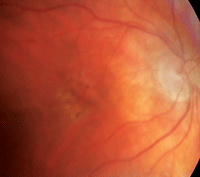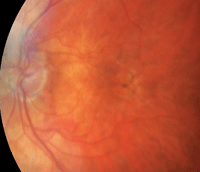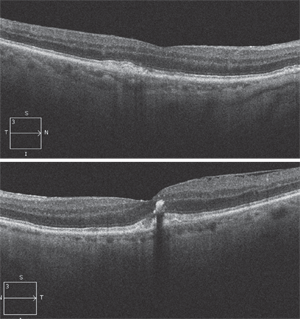 An 84-year-old Hispanic male presented with complaints of dryness and irritation in both eyes. The patient stated that, in the past, he had “some issues with eyelashes poking him in the eyes,” which caused irritation and required removal. At the time of this visit, however, he reported that he saw well and that his vision was stable.
An 84-year-old Hispanic male presented with complaints of dryness and irritation in both eyes. The patient stated that, in the past, he had “some issues with eyelashes poking him in the eyes,” which caused irritation and required removal. At the time of this visit, however, he reported that he saw well and that his vision was stable.
His ocular history was significant for successful cataract surgery in both eyes approximately seven years earlier. His medical history was remarkable for type 2 diabetes and hypertension. The patient reported taking a number of medications for both systemic conditions, but couldn’t remember their names.
His best-corrected visual acuity was 20/25 O.D. and 20/30 O.S. Confrontation fields were full to careful finger counting O.U. The pupils were equally round and reactive, with no evidence of afferent defect. Amsler grid testing was normal.
During the anterior segment evaluation, we observed several misdirected eyelashes involving the upper lids in both eyes that were rubbing on the superior corneas. This low-grade mechanical trauma caused the development of mild punctate epithelial erosions O.U.
In addition, we noted that the patient’s bilateral posterior chamber intraocular lenses were well centered, with clear visual axes.
The dilated fundus examination showed significant asteroid hyalosis in both eyes, which partially obscured our view of the retina. He appeared to have healthy optic nerves, with small cups and good rim coloration and perfusion O.U. We noted obvious changes in both maculae on fundus photography (figures 1 and 2). Additionally, we obtained a spectral-domain optical coherence tomography (SD-OCT) scan (figures 3 and 4) and performed fundus autofluorescence (FAF) imaging.
Take the Retina Quiz
1. What is the correct diagnosis in this case?


1, 2. We noted peculiar macular changes in our patient (O.D. left, O.S. right). What do they represent?
a. Pattern dystrophy of the retinal pigment epithelium (RPE).
b. Dry age-related macular degeneration (AMD).
c. Wet AMD.
d. Central serous chorioretinopathy.
2. What finding does the SD-OCT scan show in the patient’s left eye?
a. Choroidal neovascularization (CNV).
b. Geographic atrophy.
c. Serous detachment.
d. Pigment migration into the sensory retina.
3. What is the underlying etiology?
a. Age-related.
b. Degenerative disorder.
c. Hereditary.
d. Response to stress.
4. How should this patient be managed?
a. Observation.
b. Laser.
c. Intravitreal injection of an anti-VEGF agent.
d. Pars plana vitrectomy.
For answers, see below.
Discussion
The view into our patient’s retina was made difficult secondary to asteroid hyalosis O.U. However, on careful evaluation, unusual RPE changes could be seen in both maculae. There appeared to be RPE pigment clumping and mottling in an almost linear, radiating pattern (O.D. > O.S.), as well as lighter areas of surrounding RPE depigmentation.
In the left eye, there was a plaque of pigment that appeared superficial––unlike what was seen in the right eye (or even elsewhere in the left eye). What was most unusual is that the plaque of pigment appeared to be within the sensory retina. Drusen also appeared to be present; however, this was difficult to determine because of the asteroid hyalosis. No fluid was detected in either eye.
The SD-OCT scan of the right eye showed thickening of both the RPE and Bruch’s membrane, with an intact interior segment/outer segment junction. Further, the SD-OCT confirmed the absence of any subretinal fluid or CNV. The SD-OCT scan of the left eye also showed diffuse thickening of the RPE/Bruch’s membrane complex.

3, 4. The SD-OCT scans of both maculae (O.D. top, O.S. bottom). What do you notice?
However, we also documented a highly reflective “spot” within the sensory retina that was located temporal to the fovea, which resulted in posterior shadowing. On careful inspection of the retina and fundus photographs, the spot likely represents an area of intraretinal pigment––not a CNV.
So, what’s wrong with our patient? He likely has a pattern dystrophy of the RPE. Pattern dystrophies represent an autosomal group of disorders that present in midlife, with mild visual disturbances in one or both eyes.
Because many patients with this condition may present later in life, they are often referred out or misdiagnosed with AMD. This is incorrect, however, because the pattern dystrophies are not a form of AMD––but rather a separate and distinct disease process.
It is important to note, however, that because most patients who develop pattern dystrophies are of advanced age, drusen may be present (as was the case in our patient). But again, drusen formation is indicative of a separate disease process that must be followed and managed accordingly.
Patients with pattern dystrophies can present with a variety of macular changes that appear like deposits of yellow, orange or gray pigment mottling in the macular area. Based upon the pattern of pigment distribution within the macula, this disease has been subdivided into at least five principle groups:1
- Adult-onset foveomacular vitelliform dystrophy. Patients in this group may have lesions that can simulate those commonly seen in Best disease.
- Butterfly-shaped pigment dystrophy. This form is characterized by yellowish flecks that concentrate in the macula, and may spread throughout the posterior pole. As the name suggests, the lesions can simulate the appearance of a butterfly. This pattern dystrophy has been linked to a mutation in the RDS/peripherin gene.2
- Reticular dystrophy of the RPE. This form of pattern dystrophy can present with a reticulated “fishnet” appearance, in which the RPE changes are more contiguous with one another.
- Multifocal pattern dystrophy simulating fundus flavimaculatus. These individuals exhibit pisciform changes that are commonly seen in patients with Stargardt’s macular dystrophy. Unlike patients with Stargardt’s, however, there is no angiographic evidence of a dark choroid.1
- Fundus pulverulentus. Patients with this form show prominent, coarse “punctiform” mottling of the RPE in the macular area.1
So, which type of pattern dystrophy does our patient have? It is somewhat evident that our patient exhibits a butterfly-shaped pattern, which can be better appreciated in the right eye (with a little imagination). Although infrequently documented, choroidal neovascularization may occur in any of the subgroups. Still, the patient’s prognosis for maintaining good vision is excellent.
We explained the findings to our patient. We removed the misdirected eyelashes, and recommended the use of artificial tears. Additionally, we suggested vitamin supplements that contained lutein and zeaxanthan.
We asked the patient to return in one year for follow-up.
1. Gass JD. Stereoscopic Atlas of Macular Disease, 3rd ed. St. Louis: CV Mosby Co.; 1987:252-61.
2. Zhang K, Garibaldi DC, Li Y, et al. Butterfly-shaped pattern dystrophy: a genetic, clinical, and histopathological report. Arch Ophthalmol. 2002 Apr;120(4):485-90.
Answers
1. a
2. d
3. c
4. a

